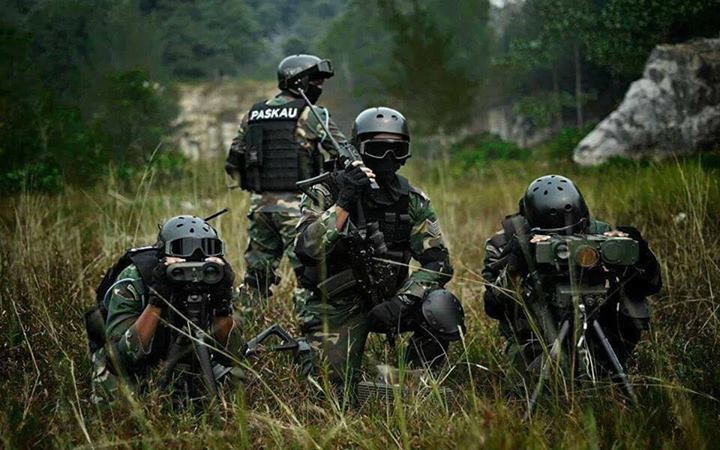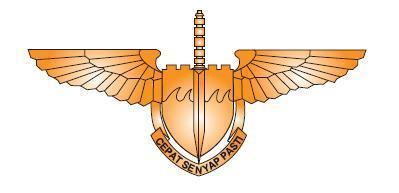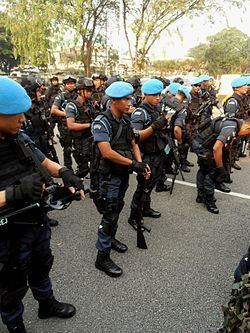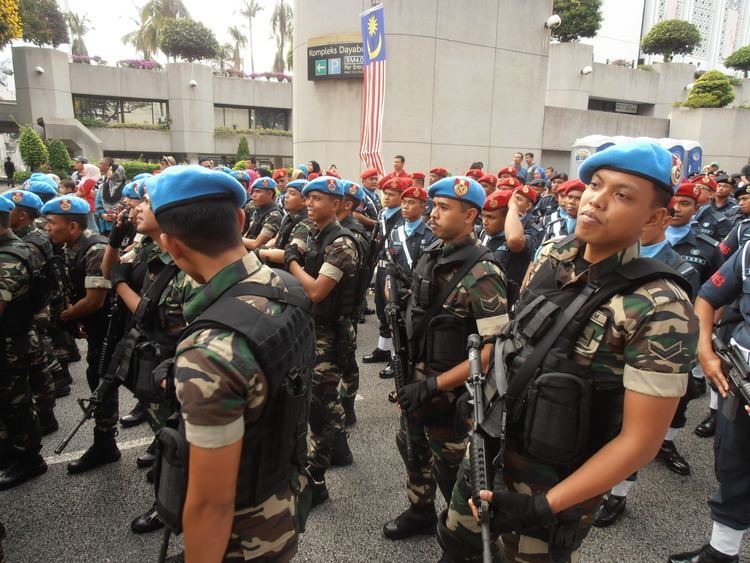Country Malaysia | ||
 | ||
Active 1 April 1980 – known as HANDAU1 June 1993 – PASKAU Type Air Force Special Operations Role Special operationsCounter-terrorismReconnaissanceHostage rescue Size Flight Hostage Rescue TeamCombat Air Rescue SquadronForce Protection Squadron | ||
airtimes pasukan khas udara paskau dan empat skuadron penerbangan tudm di anugerah panji panji
The Pasukan Khas Udara (English: Air Force Special Air Service, Jawi:ڤاسوكن خاص اودارا) formerly the Malaysian abbreviation known as PASKAU, is a special counter-terrorism force and special operations tactical within the Royal Malaysian Air Force (RMAF). Its main responsibility is to conduct combat search and rescue missions (CSAR) and the recovery of downed aircrew. PASKAU is also a fully qualified counter-terrorist assault unit.
Contents
- airtimes pasukan khas udara paskau dan empat skuadron penerbangan tudm di anugerah panji panji
- Paskau tudm gltd 1
- History
- Organisation
- Training and expertise
- Role
- Handguns
- Shotguns
- Submachineguns
- Carbines
- Counter sniper rifles
- Designated Marksman Rifles
- Sniper rifles
- Machineguns
- Grenade Launchers
- Functions
- Target marking
- Security of important assets
- Search and rescue
- Counter Terrorism
- Mobility
- Flexibility
- Sustainability
- Technology
- Special training
- Mission and the future
- Operation Daulat
- MALCON ISAF
- Genting Sempah Incident
- MALCON UNIFIL 2007
- Hawk 208 crash
- Bukit Batu Tiban Incident
- Brinchang Incident
- Piper 28 crash
- PASKAU boat capsizing
- Bukit Galla Incident
- Gunung Gerah incident
- References

It has a specialised Hostage Rescue Team (HRT) and can be deployed behind enemy lines to assist in target designation for RMAF offensive missions.
On 24 January 2008, the Sultan of Pahang, Sultan Ahmad Shah, was made an Honorary Colonel of the unit when he honoured the Honor Beret of PASKAU by Chief of Air Force, General Tan Sri Azizan Bin Ariffin RMAF at RMAF Regiment, Bukit Jugra, Selangor.

Paskau tudm gltd 1
History

PASKAU can trace its beginnings to the 1970s and a mortar attack by Malayan Communist Party agents from outside an RMAF airbase, Kuala Lumpur; it resulted in the destruction of a RMAF DHC-4 Caribou transport aircraft.

From this incident, a specific directive from the RMAF led to the formation of an operation force for the security of RMAF airbases which was previously the responsibility of the Royal Military Police Corps (RMPC). An elite force, it was known as Pasukan Pertahanan Darat dan Udara (English: Air and Ground Defence Force) or by its abbreviation HANDAU; it was established on 1 April 1980. The new force received training from the army's special forces. They also received special training from the British Special Air Service and the US Special Forces.

102 squadron was the first unit to take over security duties from the RMPC at RMAF air base, Kuala Lumpur, on 1 April 1980. It was followed by the establishment of ten more squadrons up to 1 March 1987.
The restructuring of the RMAF, (which was based on the modernisation of the British Royal Air Force), on 1 June 1993, included changing the name HANDAU to Pasukan Khas Udara, (abbreviated to PASKAU). In 1996, the unit strength was increased and its role expanded to include counter-terrorism, unconventional warfare and search and rescue missions.
Organisation
Now officially known as the RMAF Regiment, it is better known as PASKAU. Today, it operates directly under Headquarters, Air Operations and is based at Bukit Jugra Air Base, Banting. Below are the three main squadrons of PASKAU under the Operations Branch of the Regiment responsible for special operations.
Training and expertise
Every officer and man is presented with a light blue beret when he passes the PASKAU basic course and a commando dagger on the successful completion of the PASKAU expert course. They then carry out advanced training which allows them to take part in all operations. PASKAU personnel are tested every twelve weeks. These tests are compulsory.
- 160 kilometre walking without stopping
- Australian rappel
- Special Patrol Insertion/Extraction
- Operating a boat capable of 60 km per hour
- Jungle commando basic course
- Special infiltration and reconnaissance course
- Sniper course
PASKAU operatives are capable of conducting operations using:-
- Close Quarters Combat – CQC
- Combat diving
- Counter-insurgency
- Counter-terrorism
- Counter-sniper tactics
- Laser-designation – Using AN/PEQ-1 SOFLAM GLTD II, the units 'paint' hostile targets, marking them for attack by air-dropped laser-guided munitions such as the Paveway II LGB (laser-guided bomb)
- Marksmanship
- Sabotage
- Sang Moo Doo (multi-technique martial arts including Aikido, Judo, Karate and Taekwondo)
- Snipers
- Unconventional warfare
- High-altitude military parachuting – high altitude low opening/high altitude high opening of parachutes
- Hover jump
- Rappelling
- Special Patrol Insertion/Extraction – SPIE rig
- Special reconnaissance
- Counterintelligence
- Signal intelligence – SIGINT
- Long Range Reconnaissance Patrol
- Providing base security to RMAF installations.
- Combat Search and Rescue (The recovery of friendly units from behind enemy lines)
- Fighting In Built-Up Areas – FIBUA
- Hostage rescue
- Military Operations on Urbanized Terrain – MOUT
- OBUA – Operations in Built Up Areas
- Special demolitions
- Explosive Ordnance Disposal – EOD
PASKAU is highly capable of carrying-out hostage rescue operations in any situation and is regarded as the principal anti-hijack response for civil and military aircraft. This task was taken over from Grup Gerak Khas (Army SOF unit). The unit also took part in special training with the British SAS and the US Special Forces. On 6 May 2004, only 81 of 198 personnel received their blue berets, including the best trainee Laskar Udara Meor Mohd Nazri Othman, 23, having survived the challenging three-month series 07/2004 Basic Commando Training while in October 2007, only 20 of 54 trainees successfully completed a three-month training programme.
From 28 May 2009, PASKAU participated with the United States Air Force 320th Special Tactics Squadron in an underwater search and recovery course as part of a joint training exercise code-named Teak Mint 09-1. Besides the joint training, the USAF presented Barret M107 anti-material rifles for use by the RMAF special team. Teak Mint 09-1 is a joint training exchange designed to enhance United States – Malaysian military training and capabilities.
Role
PASKAU's establishment has increased the RMAF capability in special air operations such as Combat Search And Rescue (CSAR). It must also be capable of securing forward RMAF bases and be able to assist in the execution of airstrikes using specialist weapons. PASKAU consists of specially selected and trained RMAF regiment personnel. The role of this unit is very different from army Grup Gerak Khas; or the Navy PASKAL.
Handguns
Shotguns
Submachineguns
Carbines
Counter-sniper rifles
Designated Marksman Rifles
Sniper rifles
Machineguns
Grenade Launchers
Functions
PASKAU soon became a very important asset to the RMAF. The force normally deploys by air, both in peace and war. The capabilities of PASKAU personnel include:
Target marking
To mark a target for an airstrike, such as radar or surface-to-air-missile (SAM) sites, sub-units must be able to infiltrate behind enemy lines. The target can then be 'painted' using GLTD II.
Security of important assets
The unit must secure critical RMAF areas from enemy ground attack. The task is made harder in forward locations and other hostile environments where the threat level is higher.
Search and rescue
Search and rescue missions, on land (on both sides of the lines) and at sea, are the responsibility of PASKAU. A wide variety of circumstances are usually encountered. For instance, when a Sikorsky S61 'Nuri' helicopter crashed on the slopes of Gunung Gerah in November 1989, reaching the wreckage required abseiling into the jungle. Other SAR missions are shown in the 'Recent Operations' section further down this page.
Counter Terrorism
Incidents involving hijacked aircraft and terrorists throughout Malaysia come under the remit of PASKAU. The unit is trained to solve the problem with the least effect on the passengers and aircraft.
Mobility
PASKAU is able to be rapidly inserted into an operational area by land, air or sea.
Flexibility
The group is capable of being deployed independently or as part of a joint task force with other special operations groups.
Sustainability
The unit is able to operate independently and conduct special operations for sustained periods without external assistance.
Technology
The group has access to high-tech equipment and weaponry to improve its ability to execute complex and demanding special operations.
Special training
The group employs specialised physical training that exceeds that of conventional forces. This is to ensure that operators are well-prepared to execute highly demanding SOF-type missions. They are especially suited to classified missions involving small sub-units.
Mission and the future
The future direction for PASKAU includes the continuous expansion of the team expertise and roles as well as enhancing the team's effectiveness with newer and more capable equipment.
Operation Daulat
In March 2013, PASKAU commandos was deployed to joint operations with all branches of Malaysian Armed Forces, Royal Malaysia Police and Malaysian Maritime Enforcement Agency special forces to execution of Operation Daulat by conducting psychological warfare operations against the Sulu terrorist by dropping leaflets to urge them to lay down their weapon and surrender to the authorities. The PASKAU commandos are known for their role to paint enemy's target via GLTD to illuminate the laser guided bombs, which believe they calling the fighter jets of F/A-18D Hornet from 18th Squadron and Hawk 208 from 15th Squadron to airstrikes the terrorist camp at Kampung Tanduo, Lahad Datu.
MALCON-ISAF
The special forces included PASKAU, 10 Paratrooper Brigade, Grup Gerak Khas and PASKAL was deployed with other Malaysian contingent to involved the administrative workload at the International Security Assistance Force (ISAF) in Afghanistan. The team which 40 soldiers deployed to assisted the New Zealand Armed Forces in the peacekeeping missions and humanitarian aid at the Bamiyan District, Afghanistan.
Genting Sempah Incident
In July 2007, PASKAU, with the 10 Paratrooper Brigade, 22nd Grup Gerak Khas and the Pasukan Gerakan Khas anti-terror police, supported by the United States Navy Air Fleet (from USS Jarrett (FFG-33)), Police General Operations Force Senoi Praaq, Police Air Wing, Fire and Rescue Department, Forestry Department Rangers, Civil Defence Department (JPA3) and local villagers, were deployed in a search and rescue operation after a Sikorsy S61 'Nuri' helicopter of the RMAF went down along with a crew of six near Genting Sempah, in the Genting Highlands. The SAR team located the wreckage on 17 July at 1324hrs with its rotor blades detached. The bodies of all crew members were found in the cabin of the stricken aircraft.
MALCON-UNIFIL 2007
PASKAU was part of a contingent which also included the 10th Parachute Brigade, Grup Gerak Khas and PASKAL which were deployed to assist the administrative workload at the UN Interim Force in Lebanon (UNIFIL) headquarters in Lebanon which 160 soldiers including 3 Malaysian SOF as the Quick Reaction Team.
Hawk 208 crash
On 27 June 2006, PASKAU was involved in the search for Major Muhammad Rohaizan Bin Abdul Rahman after his Hawk 208 fighter crashed into the sea off Rompin, Pahang on 31 May 2006. The remains of the pilot were found on the seabed 28 days after the crash, 150 meters off the coast of Pantai Lanjut, Rompin, Pahang
Bukit Batu Tiban Incident
PASKAU was involved in rescue operations on 28 July 2005, after a Hornbill Skyway Bell 206 Jet Ranger helicopter crashed in Bukit Batu Tiban, Ulu Baleh, Kapit, near the Sarawak-West Kalimantan border. Three passengers and the pilot died, one passenger survived.
Brinchang Incident
On 7 June 2005, 21 PASKAU and 35 VAT 69 (Pasukan Gerakan Khas) operators were involved in the search for four children who were reported to be missing on Fraser's Hill as well as another two persons who were lost on Gunung Brinchang in the Cameron Highlands. They were all found three days later.
Piper 28 crash
PASKAU, together with the Department of Civil Aviation (DCA) and the 10th Parachute Brigade of the Malaysian Army, were involved on 14 March 2004, in the search and rescue of the occupants of a civilian Piper 28 aircraft which had crashed. The aircraft went down in a heavily forested area 3.2 kilometres south-west of the Langat Dam, Selangor. The pilot, Captain Nasir Ma Lee Bin Abdullah, was killed while the passenger, Nazarullah Bin Mohd Sultan, was found alive.
PASKAU boat capsizing
On 19 January 2003, a fibreglass boat carrying two senior officers and four servicemen from PASKAU capsized after encountering large waves in stormy conditions. This occurred during reconnaissance operations in the vicinity of Sibu Island, Johore at around 10:30 am. RMAF Majors Audrey Smith and Damian Sebastian, Sergeants Radzi Bin Abdul Majid and Saad Bin Che Omar were safely recovered while Corporals Hasnul Bin Abdul Rahman and Ayub Bin Sidek perished.
Bukit Galla Incident
PASKAU with RMP General Operations Force, the State Forestry Department, the Civil Defence Department (JPA 3), the Department of Civil Aviation and the Negeri Sembilan Fire and Rescue Department, were involved on 20 February 1999, in search and rescue operations after a civilian Beachcraft BE-36 aircraft crashed into the slopes of Bukit Galla, Mantin, Negeri Sembilan. The pilot and his passenger, Patrick Dutrey and Natalie Marie Chappate, were killed.
Gunung Gerah incident
On 14 November 1989, PASKAU was involved in rescue operations after a TUDM Sikorsky S61 'Nuri' helicopter went down on the slopes of Gunung Gerah and Gunung Bilah near the Kelantan-Perak border. 21 passengers were killed, including 15 policemens from the General Operations Force of the Royal Malaysia Police.
